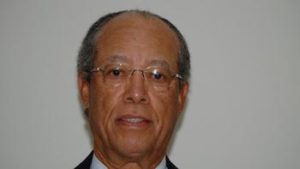
William M. Jackson
*William M. Jackson was born on this date in 1936. He is a Black Research Chemist in astrochemistry and an Emeritus Professor.
William Morgan Jackson was born in Birmingham, Alabama. He grew up in Dynamite Hill, an area of the city that the Ku Klux Klan frequently bombed during the 20th-century American Civil Rights movement. His father owned the Apex Cab Company and taught auto mechanics at Parker High School; his mother, a Santa Barbara Junior High School graduate, worked for the US Government. At the age of nine, Jackson contracted polio, and he had to spend a year out of school. A
After completing tenth grade, Jackson joined Morehouse College as an early entrance student. He was awarded a full scholarship. At first, Jackson considered majoring in mathematics but decided to study chemistry after meeting Henry Cecil McBay. He graduated in 1956 and applied to several graduate schools, including Northwestern University and Purdue University. He received a response from Northwestern, which said they had already completed their three fellowships for African American students. Eventually, he moved to Washington, D.C., where he got a job and lived with his cousin.
He studied at the Catholic University of America and was awarded a postgraduate research fellowship. During his doctoral studies, he worked in the Harry Diamond Laboratories, where he studied molten salt compounds. During the final year of his Ph.D., Jackson's wife became pregnant, and Jackson took time out of graduate school to earn money.
During this time, he worked at the National Institute of Standards and Technology. He returned to the Catholic University of America, where he studied gasoline additives. After earning his Ph.D. in 1961, he joined Lockheed Martin, where he worked on formaldehyde resins and ways to protect missiles as they reenter the Atmosphere of Earth.
He returned to the National Institute of Standards and Technology as a postdoctoral researcher, studying how radiant energy impacted chemical structures. He investigated how radiation impacted the coating applied to space vehicles. In 1964, Jackson joined the Goddard Space Flight Center. Here, he became interested in the origins of free radicals in comets.
While at the Goddard Space Flight Center, he proposed using the International Ultraviolet Explorer satellite to look for comets. Using the Haystack Observatory, Jackson measured water emissions in comets. He joined the University of Pittsburgh faculty in 1969, where he spent a year researching and teaching.
At the University of Pittsburgh, he worked with Wade Fite and Ted Brackman on detecting electron impact on molecules using mass spectrometry. A year later, he returned to Goddard, where he developed a system to detect free radicals using laser beams. In 1974, one of Jackson's colleagues, a Professor of Chemistry at Howard University, died suddenly.
Jackson agreed to teach his course for the rest of the term and was subsequently appointed to a joint position in chemistry and physics. Here, he began working on laser-induced fluorescence (LIF) to study the rovibronic coupling in cyano radicals. He was the first person to demonstrate LIF could be used to study molecular photodissociation.
He primarily studied comets using satellite ground-based telescopes, using experimental data and theoretical predictions to establish how the free radicals inside comets form. Despite leaving Goddard Space Flight Center, Jackson served as team leader for the International Ultraviolet Explorer telescope, which observed Halley's Comet.
He joined the University of California, Davis, in 1985 and was promoted to Distinguished Professor in 1998. The Jackson Laboratory ("Jackson’s Photon Crusaders") developed tunable lasers that could detect and characterize free radicals. These included excimer lasers, nitrogen-pumped lasers, and an Alexandrite laser.
By building laser systems in the laboratory, Jackson helped establish the excited states of molecules in planetary atmospheres. The experiments consisted of one laser for the photodissociation of the parent molecule and another laser to excite the free radical into an excited state. When the excited molecule fluoresced back to the ground state, the fluorescence was captured in a photomultiplier tube. He has investigated carbon monoxide, nitrogen, and carbon dioxide photochemistry. His laser systems exploit resonant four-wave mixing, which allows them to photo-dissociate gases observed in planetary atmospheres. He also showed that ionizing the resulting atomic fragments is possible using a velocity imaging time-of-flight mass spectrometer. In 1996, the Planetary Society named asteroid 1081 EE37 (4322) Billjackson in his honor. He served as Chair of the Department of Chemistry at the University of California, Davis in 2000.
He retired in 2006 but has continued to research and recruit students. 2013, he was made the Emile A. Dickenson Professor at the University of California, Davis. 2019, the Journal of Physical Chemistry dedicated a special issue to Jackson. He has campaigned for equity, diversity, and inclusion in science since he started his career. He was one of the founders of the National Organization for the Professional Advancement of Black Chemists and Chemical Engineers (NOBCChE). The organization began to promote and award minority scientists and engineers and encourage high school students to consider studying science or engineering.
Ted Kennedy and the National Science Foundation supported it. Jackson served as NOBCChE's first treasurer from 1973. He stated that he was inspired to start the NOBCChE after attending a meeting of the American Chemical Society and seeing no Blacks there. He has served in various capacities for the NOBCChE, attending every annual meeting other than one (San Diego, 1999) in protest of the 1996 California Proposition 209.
He provided evidence to Congress to increase research funding to historically black colleges and universities. When he arrived at UC Davis, only two students from underrepresented minorities had ever earned chemistry Ph. D.s there. While at UC Davis, he secured funding from the Alfred P. Sloan Foundation and increased the department's minority student population to about 15% of the academic cohort. Jackson was known for bringing students and researchers to his laboratory “who were the stones the builders rejected, and he made them the cornerstones for future scientific research”.